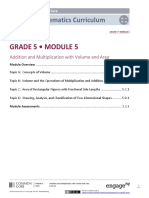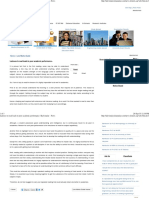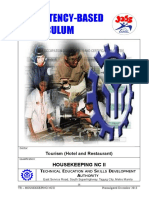Bryanston Primary School: Mathematics Grade 5 (MR ECM Bradley)
Uploaded by
erinconradBryanston Primary School: Mathematics Grade 5 (MR ECM Bradley)
Uploaded by
erinconradBryanston Primary School
Mathematics Grade 5 (Mr ECM Bradley)
Term 2: 2017
Date: 25 April Tuesday
Monday-02-May 26 April Wednes
Tuesday-03-May 27 April Thursday
Wednesday-04-May 28 April Friday
Thursday-05-May 2Friday-06-May
May Tuesday
Content Basic Multiplication:
Public Holiday Division is the inverse of Division is the inverse of Properties of 3D objects. The Interpret diagrams of 3D
Using the column method multiplication multiplication Recognising and naming 3D objects
objects
Context Getting a hold of the basic A further Focussing on how Division is the inverse of Recognising and naming 3D Looking at the length,
method of doing this -also multiplication and division are multiplication, Looking at the key objects height, face, width of the
incorporating the inverse inverses e.g., '12 x 7 = 84 can be word: average speed, To begin ------------------------------------------- various aspects.
operation of division, to written as 84/7 = 12 or 84 /12 =7; with, ask learners if they know of Describing, sorting and comparing
check the answer. Going over the method that will be
any units in real life that are 3D objects, making 3D models, Like looking at the concepts
used in the forthcoming
assessment. written as something per __ . Interpreting diagrams of 3D objects of solid objects as objects
Encourage them to think of that you can see around
speeds or the price of food. They
you, like books and tables.
might come up with ideas such
They are also called three-
as kilometres per hour, rands per
kilogram, rands per litre and so dimensional (3D) objects.
forth and so on. This was not fully
tackled in the previous week.
Time allocation 1 hour Refer to the timetable.
Resources Various exercise in the Multiplication: (1) Viva Mathematics, Grade 5. (2) Counters (3) Platinum Mathematics
textbook (workbook), the 3D Shapes: Pictures of 3D shapes, actual 3 dimensional forms. pictures of examples e.g., pyramids, grid paper, rulers, models.
interactive whiteboard objects in the environment and so forth. These can be drawn outdoors. e.g., tin of jam and a shoe.
Recorded Basic evaluation of the TOOL: Class Lists, Observation Sheet, Questionaire, TOOL: Formal Test, JournalS, Structured Questions and
Assessment exercises done Structured Questions and Written Assignments. Worksheets.
1 Mathematics Learning Programme 2016
Bryanston Primary School
METHOD: Informal aural questions, observation, peer METHODS: Demonstrations, Educator Assessment,
Assessment (Learner to Learner), recognizing prior learning Observation, Self Assessment.
(RPL), self assessment. TYPES: baseline assessment of prior learning, diagnostic
TYPES: baseline assessment of prior learning assessment in preparing for Examination.
Reflection Need to appraise the MULTIPLYING: Need to reiterate the looking at the key Types of 3D objects: Types of 3D objects e.g., a prism , a cube,
misunderstanding of the word: average speed. Also the need to make sure that they pyramids. A prism having two opposite faces. The two faces are
example, given on the know that the word 'per' means 'for one'. An example: per opposite, identical (equal) polygons, with exactly the same size and
board. shape.
kilogram means for one kilogram and so on. These units are
usually written as R/kg and km/h to show that the units are
Key words: face - a flat surface of an object, prism - a 3D object with
being divided. two identical, parallel end faces, pyramid - a 3D object that has a
square base and all its other faces as triangles, base - the face on
which the object rests, identical being exactly the same
Problem Areas: Need to help learners to avoid get confused with the two -factors are smaller than THE PROPERTIES OF THESE SHAPES: A prism has two opposite
the given number (or the same size) and multiples are bigger than the given number faces. The two faces are opposite, identical (equal) polygons,
(or the same size). with exactly the same size and shape.
Revise how to estimate the answer first and then how to multiply by 10 and by 100. A CUBE: all the faces of a cube are equal squares.
Do the given examples together to show how to multiply by first breaking down the
numbers into factors. PYRAMIDS: A pyramid has a polygon as its base. The other
faces of a pyramid are triangles, because the edges of a
pyramid come to a single point above the base.
Extension Practice of this in the course of learning. Encourage the learners to look for examples of 3D shapes in
the world around.
Homework Refer to the study guide.
2 Mathematics Learning Programme 2016
You might also like
- (eBook PDF) Teaching Primary Mathematics 6th Edition 2024 scribd download100% (2)(eBook PDF) Teaching Primary Mathematics 6th Edition 2024 scribd download51 pages
- PDF (Ebook PDF) Teaching Primary Mathematics 6th Edition Download50% (2)PDF (Ebook PDF) Teaching Primary Mathematics 6th Edition Download49 pages
- Cambridge Primary Mathematics Skills Builder 4100% (2)Cambridge Primary Mathematics Skills Builder 420 pages
- Cambridge Primary Mathematics Skills Builder 580% (5)Cambridge Primary Mathematics Skills Builder 520 pages
- .Archgr 6 Term 3 MATHEMATICS Teacher Resource Pack (2023)No ratings yet.Archgr 6 Term 3 MATHEMATICS Teacher Resource Pack (2023)16 pages
- Study Master Mathematics Grade 6 Teacher S Guide100% (4)Study Master Mathematics Grade 6 Teacher S Guide525 pages
- Bryanston Primary School: Mathematics Grade 5 (MR ECM Bradley)No ratings yetBryanston Primary School: Mathematics Grade 5 (MR ECM Bradley)2 pages
- Bryanston Primary School: Mathematics Grade 5 (MR ECM Bradley)No ratings yetBryanston Primary School: Mathematics Grade 5 (MR ECM Bradley)3 pages
- Bryanston Primary School: Mathematics Grade 5 (MR ECM Bradley)No ratings yetBryanston Primary School: Mathematics Grade 5 (MR ECM Bradley)3 pages
- Common Misconceptions in Mathematics DraftNo ratings yetCommon Misconceptions in Mathematics Draft7 pages
- Mathematics Intermediate Phase Term 2 Teaching Pace Setter 2020No ratings yetMathematics Intermediate Phase Term 2 Teaching Pace Setter 20203 pages
- tp-n-2546471-year-2-multiplication-and-division-planit-maths-steps-to-progression-overview_ver_8No ratings yettp-n-2546471-year-2-multiplication-and-division-planit-maths-steps-to-progression-overview_ver_811 pages
- Primary Maths Stage 3 - Test 2 (Unit5_4)No ratings yetPrimary Maths Stage 3 - Test 2 (Unit5_4)3 pages
- (eBook PDF) Teaching Primary Mathematics 6th Edition instant downloadNo ratings yet(eBook PDF) Teaching Primary Mathematics 6th Edition instant download47 pages
- Cambridge Primary Mathematics Stage 1 Skills Builder PDF FreeNo ratings yetCambridge Primary Mathematics Stage 1 Skills Builder PDF Free65 pages
- Download ebooks file (eBook PDF) Teaching Primary Mathematics 6th Edition all chapters100% (2)Download ebooks file (eBook PDF) Teaching Primary Mathematics 6th Edition all chapters50 pages
- SAT Math Level 2 Subject Test Guide – The PhD Tutor Method 2013 Edition Part TwoFrom EverandSAT Math Level 2 Subject Test Guide – The PhD Tutor Method 2013 Edition Part Two3/5 (2)
- Mikayla Ferguson - Grade 5C - 3D Shapes: Triangular PyramidNo ratings yetMikayla Ferguson - Grade 5C - 3D Shapes: Triangular Pyramid1 page
- Lesson Plan Template For Mobile Infused Lessons Intermediate Phase EnglishNo ratings yetLesson Plan Template For Mobile Infused Lessons Intermediate Phase English3 pages
- Date: January 2019: Raw Bolts To Be InclNo ratings yetDate: January 2019: Raw Bolts To Be Incl1 page
- DIARY - TERM 2, 2016: General AnnouncementsNo ratings yetDIARY - TERM 2, 2016: General Announcements4 pages
- Movies On TH E Field: General AnnouncementsNo ratings yetMovies On TH E Field: General Announcements3 pages
- DIARY - TERM 3, 2016: Message From The PrincipalNo ratings yetDIARY - TERM 3, 2016: Message From The Principal4 pages
- Bryanston Primary School: Grade 5 Mathematics (MR ECM Bradley)No ratings yetBryanston Primary School: Grade 5 Mathematics (MR ECM Bradley)3 pages
- Message From The Principal: DIARY - TERM 1, 2017No ratings yetMessage From The Principal: DIARY - TERM 1, 20175 pages
- General Announcements: DIARY - TERM 1, 2017No ratings yetGeneral Announcements: DIARY - TERM 1, 20173 pages
- DIARY - TERM 4, 2015: General AnnouncementsNo ratings yetDIARY - TERM 4, 2015: General Announcements4 pages
- DIARY - TERM 1, 2016: Message From The PrincipalNo ratings yetDIARY - TERM 1, 2016: Message From The Principal4 pages
- Reading Exam Quiz Worksheet Jobs Medical VNo ratings yetReading Exam Quiz Worksheet Jobs Medical V4 pages
- K To 12 Curriculum For CEAP-NBEC Usec Ocampo 28 Jan 2014No ratings yetK To 12 Curriculum For CEAP-NBEC Usec Ocampo 28 Jan 201419 pages
- KOR 380: Korean Proficiency Through TV Dramas Hybrid Online CourseNo ratings yetKOR 380: Korean Proficiency Through TV Dramas Hybrid Online Course4 pages
- Laziness To Read Leads To Poor Academic Performance - Kalvimalar - NewsNo ratings yetLaziness To Read Leads To Poor Academic Performance - Kalvimalar - News3 pages
- Relationship Between Gender and Employment Contexts of Bicol University Graduates PDFNo ratings yetRelationship Between Gender and Employment Contexts of Bicol University Graduates PDF9 pages
- UT Dallas Syllabus For Chem2323.001.09s Taught by Sergio Cortes (Scortes)No ratings yetUT Dallas Syllabus For Chem2323.001.09s Taught by Sergio Cortes (Scortes)7 pages
- Competency Based Curriculum - HousekeepiNo ratings yetCompetency Based Curriculum - Housekeepi91 pages
- Output 1 - Captured Publication.: Scored Using A Rubric by Classmates. (Peer Assessment)No ratings yetOutput 1 - Captured Publication.: Scored Using A Rubric by Classmates. (Peer Assessment)3 pages
- Principles and Techniques in Designing, Developing and100% (1)Principles and Techniques in Designing, Developing and91 pages
- Music Education in The Philippines:: Gerard JACINTO0% (1)Music Education in The Philippines:: Gerard JACINTO10 pages
- Staying Connected: Hoffman Says Yes!' To CommunityNo ratings yetStaying Connected: Hoffman Says Yes!' To Community4 pages
- MY DAILY LESSON PLA 6th GRADE Present PerfectNo ratings yetMY DAILY LESSON PLA 6th GRADE Present Perfect6 pages
- Teaching Reading Across The Disciplines: Core Practice 13No ratings yetTeaching Reading Across The Disciplines: Core Practice 133 pages
- How To Effectively Integrate ICT in ClassroomNo ratings yetHow To Effectively Integrate ICT in Classroom28 pages
















































































































